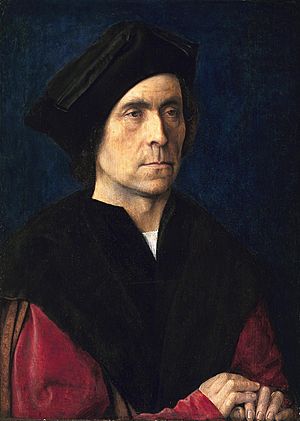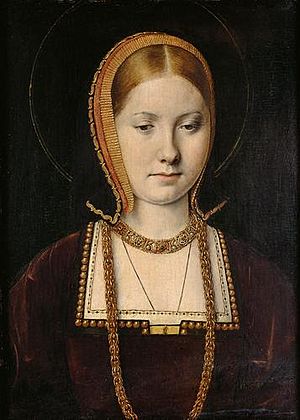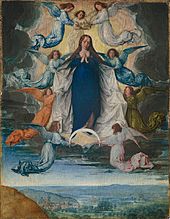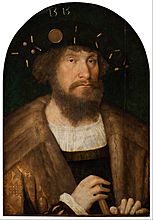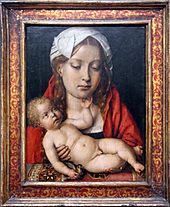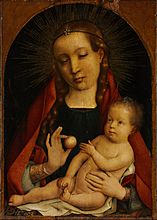Michael Sittow facts for kids
Quick facts for kids
Michael Sittow
|
|
|---|---|
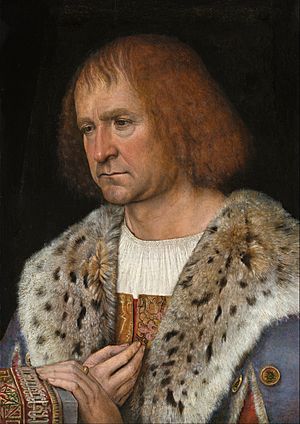
Diego de Guevara by Sittow, c. 1517
|
|
| Born | c. 1469 Reval (Tallinn), Estonia
|
| Died | 1525 Reval (Tallinn), Estonia
|
| Education | Hans Memling |
| Known for | Painting, Portraits |
| Movement | Early Netherlandish painting |
Michael Sittow was a famous painter from Estonia, born around 1469. He was also known by names like Master Michiel. He learned to paint in the style of Early Netherlandish painting. For most of his life, Sittow worked as a special painter for kings and queens. He painted portraits for important families like Isabella of Castile and the Habsburgs in Spain and the Netherlands. Many people think he was one of the most important painters from the Flemish region during his time.
Contents
A Painter's Life
Michael Sittow was born in 1468 or 1469 in Reval (now Tallinn), a busy trading city in Estonia. His family was wealthy. His father, Clawes Sittow, was also a painter and wood-carver. His mother, Margarethe Mölner, came from a rich merchant family in Finland.
Michael first learned to paint and sculpt in his father's workshop. He also went to school to study Latin, math, and singing. After his father passed away in 1482, Michael continued his art studies. From 1484 to 1488, he trained in Bruges (now in Belgium). It's believed he was an apprentice with the famous painter Hans Memling.
Around 1488, Michael Sittow became an independent artist. He traveled through southern Europe, and his paintings started to show influences from French and Italian art.
Working for Royalty
From 1492, Sittow worked as a court painter for Queen Isabella of Castile in Toledo, Spain. Queen Isabella gathered many talented artists from different countries. Sittow was known as "Melchior Alemán" (the German) at her court. He was the highest-paid painter, earning much more than other artists. He even worked with another painter, Juan de Flandes, on a series of small paintings about the lives of Christ and the Virgin Mary for the queen.
Sittow officially worked for Queen Isabella until she died in 1504. However, he had left Spain two years earlier. He was likely working in Flanders for Isabella's son-in-law, Philip the Handsome, and her daughter-in-law, Margaret of Austria. He painted a portrait of Philibert the Good, Duke of Savoy.
When Philip died in 1506, Sittow lost his royal patron. He returned to Reval that same year.
Returning Home
Back in Reval, Michael Sittow faced a problem. His stepfather had taken over his parents' houses after his mother died. Sittow had to go to court to get his inheritance back. He won the case, but he couldn't fully claim his parents' houses until his stepfather died in 1518.
In 1507, Michael Sittow joined the Guild of Kanut, which was the local painters' guild. Even though he was famous in Europe, he had to prove himself again. He was accepted as a journeyman and had to create a special "masterpiece" to become a full master craftsman in the guild. During this time, he completed various local art projects.
More Royal Commissions
In 1515, Sittow was back in Spain. He was there to collect money that Queen Isabella still owed him. It seems he was also working for Archduchess Margaret of Austria. In 1514, Sittow visited Copenhagen to paint a portrait of Christian II of Denmark. This portrait was part of plans for Christian II to marry Margaret's niece, Isabella of Austria. The portrait seen today in Copenhagen's Statens Museum for Kunst is likely a copy.
Some people believe Sittow also painted a portrait of Mary Tudor around 1514. This painting is now in the Vienna Kunsthistorisches Museum. It was once thought to be a portrait of Catherine of Aragon.
After working in the Netherlands, Sittow returned to Spain. He worked for Ferdinand II of Aragon and then for the young Spanish King Carlos I, who later became Charles V, Holy Roman Emperor. When Charles V retired, he took Sittow's wooden sculpture of the Virgin Mary and three paintings with him.
Final Years
Around 1516, Michael Sittow returned to Estonia for good. In 1518, he married Dorothie in Reval. Their son, Michel, sadly died soon after birth. In 1523, Sittow became the leader of the Guild of Kanut.
Michael Sittow died from the plague in Reval between December 1525 and January 1526. He was buried in the cemetery of the Church of the Holy Spirit, Tallinn.
Michael Sittow's Artworks
For many years, Michael Sittow's name was almost forgotten. It wasn't until 1914 that an art historian, Max J. Friedländer, suggested that "Master Michiel," the queen's painter, was the artist behind a famous two-part painting (a diptych) found near Burgos. This painting showed the Virgin and Child on one side and a Knight of the Order of Calatrava on the other. Later, in 1940, another historian, Paul Johansen, finally confirmed that the mysterious Master Michiel was indeed Michael Sittow from Reval.
Michael Sittow mostly painted small religious artworks and portraits. His paintings often have a thoughtful or even sad feeling. His style was greatly influenced by his teacher, Hans Memling. He also learned from the elegant portraits of Jean Perréal.
Sittow used thin, see-through layers of paint. This helped him create very soft and beautiful color combinations. He was also very good at showing light effects and different textures in his paintings. Art expert E. P. Richardson described Sittow as a "brilliant painter of religious subjects, but of outstanding qualities as a portrait painter." He said Sittow's portraits were "vivid, candid, crisply elegant and reserved."
It's hard to say for sure which paintings are by Sittow because he didn't sign many of his works. Only two very small paintings from a large series for Queen Isabella can be definitely linked to him. The portrait of Don Diego de Guevara (now in Washington, D.C.) and the Virgin and Child painting that went with it are almost certainly by him. This is because Diego's son mentioned his father's portrait by Sittow.
The only painting that can be dated for sure is the portrait of Christian II of Denmark. More than thirty artworks are thought to be by Michael Sittow, but most of them don't have official documents to prove it. Many of his paintings and almost all of his sculptures have been lost over time.
Famous Works
- Virgin and Child (left side of a two-part painting), Gemäldegalerie, Berlin
- Portrait of Diego de Guevara (right side of a two-part painting), Washington, D.C., The National Gallery of Art
- Virgin and Child (Budapest, Szépművészeti Múzeum)
- Portrait of Christian II, King of Denmark (Copenhagen, Statens Museum for Kunst)
- Portrait of a noblewoman, possibly Mary Tudor or Catherine of Aragon, Vienna, Kunsthistorisches Museum
- Catherine of Aragon as the Magdalene, Detroit Institute of Arts
- Virgin and Child with St. Bernard (Madrid, Museo Lázaro Galdiano)
- Portrait of a Man with a Pearl (Madrid, Palacio Real)
- Christ Carrying the Cross, Moscow, Pushkin Museum
- Coronation of the Virgin (Paris, Louvre)
- Portrait of a Lady (Paris, Louvre)
- Passion Altarpiece (St. Nicholas' Church, Tallinn)
- Portrait of a Man, The Hague, Mauritshuis
- Nativity, Vienna, Kunsthistorisches Museum
- Assumption of the Virgin (from Queen Isabella's altarpiece), Washington, D.C., The National Gallery of Art
- Ascension (from Queen Isabella's altarpiece) (Private Collection)
In Literature
Michael Sittow is the main character in a short story by Jaan Kross called Four Monologues on St. George (1970). The story is written like a court investigation. It talks about ideas like being from a certain country, living in exile, and mixing different cultures. The book won a major award in Estonia.
Images for kids
-
Assumption of the Virgin, c. 1500
See also
 In Spanish: Michel Sittow para niños
In Spanish: Michel Sittow para niños
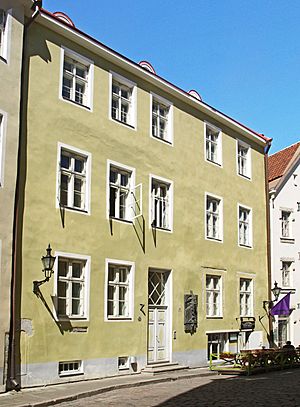
- Artists of the Tudor court
- Early Netherlandish painting
- St. Nicholas' Church, Tallinn


